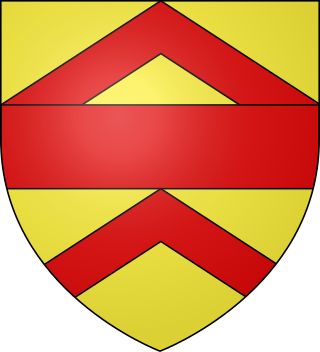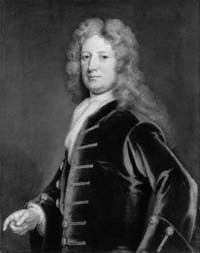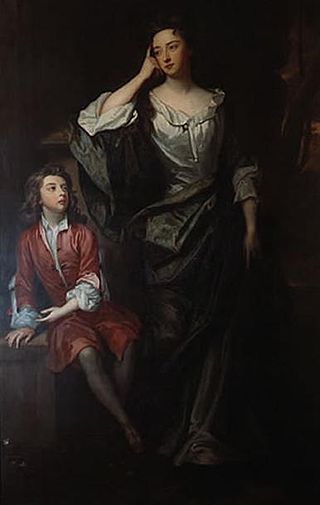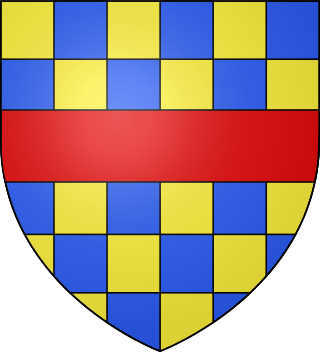
Baron Audley is a title in the Peerage of England first created in 1313, by writ to the Parliament of England, for Sir Nicholas Audley of Heighley Castle, a member of the Anglo-Norman Audley family of Staffordshire.

Duke of Grafton is a title in the Peerage of England. It was created in 1675 by Charles II of England for Henry FitzRoy, his second illegitimate son by the Duchess of Cleveland. The most notable duke of Grafton was Augustus FitzRoy, 3rd Duke of Grafton, who served as Prime Minister from 1768–1770.

Baron de Ros of Helmsley is the premier baron in the Peerage of England, created in 1288/89 for William de Ros, with precedence to 24 December 1264. Premier baron is a designation and status awarded to the holder of the most ancient extant barony of the Peerage of England. Before the Dissolution of the Monasteries the Prior of the Order of St John in England was deemed the premier baron.

Baron Mowbray is a title in the Peerage of England. It was created by writ for Roger de Mowbray in 1283. The title was united with the Barony of Segrave in 1368, when John Mowbray, 1st Earl of Nottingham and 5th Baron Mowbray succeeded to that title, and in the next generation, the Baron Mowbray was named Duke of Norfolk. With the childless death of Anne Mowbray, 8th Countess of Norfolk in c.1481, the Barony went into abeyance between the Howard and Berkeley families, and both styled themselves Baron Mowbray and Seagrave.

Baron Hastings is a title that has been created three times. The first creation was in the Peerage of England in 1290, and is extant. The second creation was in the Peerage of England in 1299, and became extinct on the death of the first holder in c. 1314. The third creation was in the Peerage of England in 1461, and has been in abeyance since 1960.

Baron FitzWalter is an ancient title in the Peerage of England. It was created on 24 June 1295 for Robert FitzWalter. The title was created by writ, which means that it can descend through both male and female lines. His great-grandson, the fourth baron, was an Admiral of the Fleet. The fourth baron's grandson, the sixth baron, died from dysentery at the siege of Harfleur. He was succeeded by his brother, the seventh baron, who was the last known male line descendant of Rollo of Normandy, and was succeeded by his daughter and only child, Elizabeth. She was the wife of John Radcliffe. Their son, the ninth baron, was attainted for treason in 1495 with his title forfeited. However, his son Robert Radcliffe obtained a reversal of the attainder by Act of Parliament in 1509 and later served as Lord Lieutenant of Lancashire. He was created Viscount FitzWalter in 1525 and Earl of Sussex in 1529. His grandson, the third earl, was summoned to the House of Lords through a writ of acceleration in 1553 in his father's junior title of Baron FitzWalter. Lord Sussex later served as Lord Deputy of Ireland. He was succeeded by his younger brother, the fourth earl. He had earlier represented Maldon, Hampshire and Portsmouth in the House of Commons and also served as Lord Lieutenant of Hampshire. When he died the titles passed to his only child, the fifth earl. He was Lord Lieutenant of Essex.

Baron Clinton is a title in the Peerage of England. Created in 1298 for Sir John de Clinton, it is the seventh-oldest barony in England.

Baron de Clifford is a title in the Peerage of England. It was created in 1299 for Robert de Clifford (c.1274–1314), feudal baron of Clifford in Herefordshire, feudal baron of Skipton in Yorkshire and feudal baron of Appleby in Westmoreland. The title was created by writ, which means that it can descend through both male and female lines. The Norman family which later took the name de Clifford settled in England after the Norman Conquest of 1066 and was first seated in England at Clifford Castle in Herefordshire. The first Baron served as Earl Marshal of England but was killed at the Battle of Bannockburn in 1314. His 8th generation descendant the 11th Baron, was created Earl of Cumberland in 1525, whose grandson the 3rd Earl was a noted naval commander. On the latter's death in 1605, the earldom passed to his younger brother, the 4th Earl.

Baron Willoughby de Eresby is a title in the Peerage of England. It was created in 1313 for Robert de Willoughby. Since 1983, the title has been held by Jane Heathcote-Drummond-Willoughby, 28th Baroness Willoughby de Eresby.
Baron Herbert is a title in the Peerage of England. It was created by writ in 1461 for William Herbert, who was later made Earl of Pembroke. The second Earl of Pembroke surrendered his earldom in return for the earldom of Huntingdon, which became extinct on his death without male issue. The barony, however, passed to his daughter Elizabeth, who later married the first Earl of Worcester. At Elizabeth's death, the title passed to her son, who later inherited his father's earldom of Worcester. Later, the fifth Earl was made Marquess of Worcester, and the third Marquess became Duke of Beaufort. Thereafter, the barony and dukedom remained united until 1984 when, upon the death of the tenth Duke without issue, the barony fell into abeyance. Then, in 2002, Queen Elizabeth II terminated the abeyance of the barony of Herbert in favour of the last holder's great-nephew, David John Seyfried.

Baron Wharton is a title in the Peerage of England, originally granted by letters patent to the heirs male of the 1st Baron, which was forfeited in 1729 when the last male-line heir was declared an outlaw. The Barony was erroneously revived in 1916 by writ of summons, thanks to an 1844 decision in the House of Lords based on absence of documentation. As such, the current Barony of Wharton could more accurately be listed as a new Barony, created in 1916, with the precedence of the older Barony.

Baron Berners is a barony created by writ in the Peerage of England.
Baron Darcy de Knayth is a title in the Peerage of England. It was created in 1332 for John Darcy with remainder to his heirs general, allowing daughters to inherit.

Baron Strange is a title which has been created four times in the Peerage of England. Two creations, one in 1295 and another in 1326, had only one holder each, upon whose deaths they became extinct. Two of the creations, that of 1299 and that of 1628, are extant. The surname Le Strange was Latinized as Extraneus. The arms of Le Strange of Knockin Castle in Shropshire were: Gules, two lions passant argent.

Earl of Plymouth is a title that has been created three times: twice in the Peerage of England and once in the Peerage of the United Kingdom.

John Charles William Fitzroy, 9th Duke of Grafton, was a British peer and politician, styled The Honourable John FitzRoy from 1914 to 1918, Viscount Ipswich in 1918, and Earl of Euston from 1918 to 1930.

Isabella Bennet FitzRoy, Duchess of Grafton and later 2nd Countess of Arlingtonsuo jure, was a British peer and heiress.

Baron Clifford is a title in the Peerage of England created by writ of summons on 17 February 1628 for Henry Clifford, Lord Clifford. The title was believed to be held by Lord Clifford's father and descending to Lord Clifford via a writ of acceleration, but it would later be determined that the Clifford title held by that family had passed to a female relative, so the summons of 1628 unintentionally created a new title. Lord Clifford inherited his father's title in 1641, whereupon he sat in the House of Lords as Earl of Cumberland until his death in 1643.

Baron Wentworth is a title in the Peerage of England. It was created in 1529 for Thomas Wentworth, who was also de jure sixth Baron le Despencer of the 1387 creation. The title was created by writ, which means that it can descend via female lines.
Jennifer Jane Forwood, 11th Baroness Arlington, is the daughter of General Sir John Nelson and Lady Margaret Jane Fitzroy, sister of the 9th Duke of Grafton.










